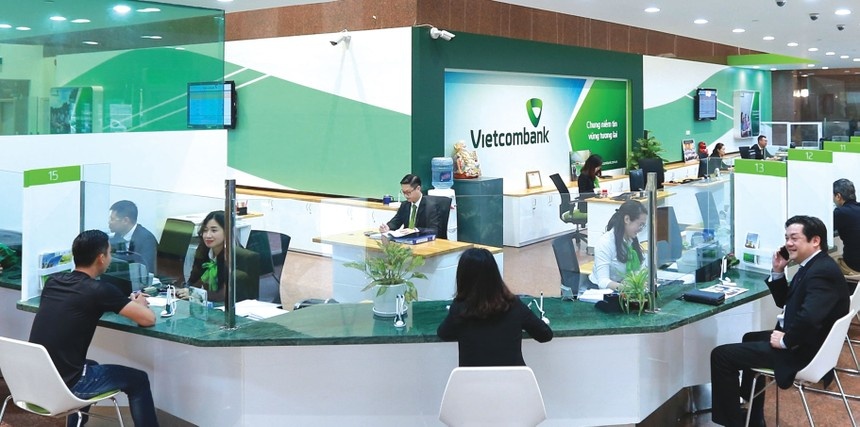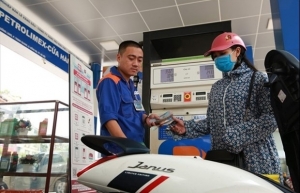Squeeze in allotted credit room for commercial banks
Vietcombank’s consumer credit balance alone climbed by 14.6 per cent at the end of June. Including existing bond investments, the bank’s loan growth is projected at about 14.4 per cent, well surpassing the central bank’s (SBV) temporary 10 per cent cap.
 |
| Squeeze in allotted credit room for commercial banks, source: TNCK |
Likewise, MBBank’s parent bank’s individual increase in client loans was 14.25 per cent at the end of June, which is close to the 15 per cent credit ceiling set by the SBV.
However, as MB is rumoured to be a potential acquirer of one of three struggling local institutions, the bank is likely to be awarded a greater credit limit thanks to any deal.
Over the same time, customer loan growth at ACB surpassed 9.8 per cent, although the rise in total credit outstanding for the whole year was just 10 per cent.
Vietcombank’s deputy general director Nguyen Thanh Tung said that the bank was temporarily given a credit growth limit of 10 per cent this year, but the real growth has reached almost this ceiling after less than half a year. “Vietcombank’s capital requirements are still significant, and without the additional credit growth, the bank is unable to satisfy customers’ lending demands,” he said.
In the same vein, Tran Phuong, deputy general director of BIDV, stated that since 2021, demand for retail and corporate loans has risen dramatically, and the growth rate given by BIDV alone cannot fulfil the genuine requirements of the bank’s clients.
The newly announced opinion of the SBV is still compatible with the aim of credit growth for the full year at 14 per cent, despite the fact that nearly all credit room has been impacted by lending activities. As of the end of July, the governing body has not yet adjusted the loan growth objective for any of the banks.
Credit in the banking sector as of July 20 was 9.27 per cent higher than the end of 2021, which is the highest increase in the first six months of the year in the past 10 years, according to the SBV’s latest figures. This growth rate exceeded the 6.47 per cent rate recorded in the first seven months of 2021.
According to SSI Securities Corporation, the SBV will raise the credit growth quota before the end of the year. However, the degree of easing may be scaled down to a more cautious level in order to prevent the rise in loans from adding to the existing level of inflationary pressure.
“It is anticipated that the increased grant ceiling will be relatively mild. Additionally, the restriction that banks must limit disbursement to potentially hazardous industries such as the real estate industry, corporate bonds, and securities will still remain in place. According to our projections, the expansion of credit throughout the whole economy might reach 15-16 per cent this year, which is 1-2 percentage points higher than the SBV’s target,” SSI noted.
Meanwhile, Vietcombank Securities Company claimed the SBV is contemplating raising more credit lines for some banks by the end of Q3 as macroeconomic indicators improve.
“Credit growth objectives are often assigned using a Basel II or Basel III-style procedure in many countries throughout the globe. Each bank’s operations and lending levels are adapted in accordance with the technical constraints established by these practices, so regulatory risk segments and levels are adjusted,” an industry insider stated.
Dinh Quang Hinh, analyst at VNDIRECT, told VIR, “With the aim of macroeconomic stability/inflation control and improving the market’s sustainability, the SBV should consider carefully when providing credit growth quota for each bank. In fact, although banks have recorded a strong credit growth in H1 2022 (up 9.35 per cent year-to-date), they have already used the full quota. And they might have to wait until at least the end of Q3 to receive a new credit growth quota from SBV. We maintain our view that Vietnam’s credit remains strong at 14 per cent on-year growth in 2022.”
The SBV noted last week that some financial organisations have been forced to close their doors due to a lack of available credit, which is mostly the result of rapid expansion during the year thus far.
“The majority of the loans offered by some banks are for the medium to long term. In addition, the inability to lend money to clients is not always caused by a shortage of available funds. Rather, it may be because of the need to maintain certain safety ratios, or it may be because certain lower-ranked banks are not permitted to have rapid credit growth,” the SBV said.
“For instance, in the real estate market, the capital turnover time is sluggish, and the debt cannot be recouped in a short amount of time, which results in the elimination of any opportunity for credit expansion,” the central bank added.
 | Banks ensure fuel firms have access to more credit The State Bank of Vietnam (SBV) has issued Document No 1509, asking commercial banks to raise credit limits for a number of fuel firms, particularly those who import extra fuel at the request of the Ministry of Industry and Trade (MoIT). |
 | Commercial banks tighten real estate lending Some banks have temporarily stopped providing loans to the real estate sector in the short term in the wake of the State Bank of Vietnam (SBV)'s policy on controlling credit growth in risky areas. |
 | Lenders reinforcing presence with bond issuance Commercial banks, with participation from local and foreign-backed institutions, are engaging in bond issuance despite severe regulations placed on this and volatile market conditions. |
 | Revenue remains a major concern for many commercial banks during digital transformation Digital transformation should be considered an ongoing process for banks, in which competition and cooperation with other partners are top priorities to enhance the customer experience, according to Luu Trung Thai, vice chairman of the board and CEO of Military Commercial Joint Stock Bank (MB Bank). |
What the stars mean:
★ Poor ★ ★ Promising ★★★ Good ★★★★ Very good ★★★★★ Exceptional
Related Contents
Latest News
More News
- Tax sector wraps up 2025 and sets priorities for next year (December 25, 2025 | 14:00)
- A tipping point for digital and hybrid wealth management in Vietnam (December 23, 2025 | 13:33)
- $250 million deal targets women-owned SMEs, sustainable agriculture (December 22, 2025 | 17:40)
- Stock market posts resilient 2025 performance (December 19, 2025 | 18:17)
- Citi Vietnam receives 2025 AmCham CSR recognition (December 19, 2025 | 16:35)
- As global green supply chain reshapes, will Vietnam be left behind? (December 19, 2025 | 08:00)
- Banks gear up for massive capital increases (December 18, 2025 | 17:04)
- Securing capital and efficiency for Vietnam’s 2026-2030 growth ambitions (December 17, 2025 | 10:00)
- Energy sector in need of blended finance mechanisms (December 17, 2025 | 09:00)
- Vietnam still has room to mobilise capital for sustainable growth (December 17, 2025 | 08:57)

 Tag:
Tag:





















 Mobile Version
Mobile Version